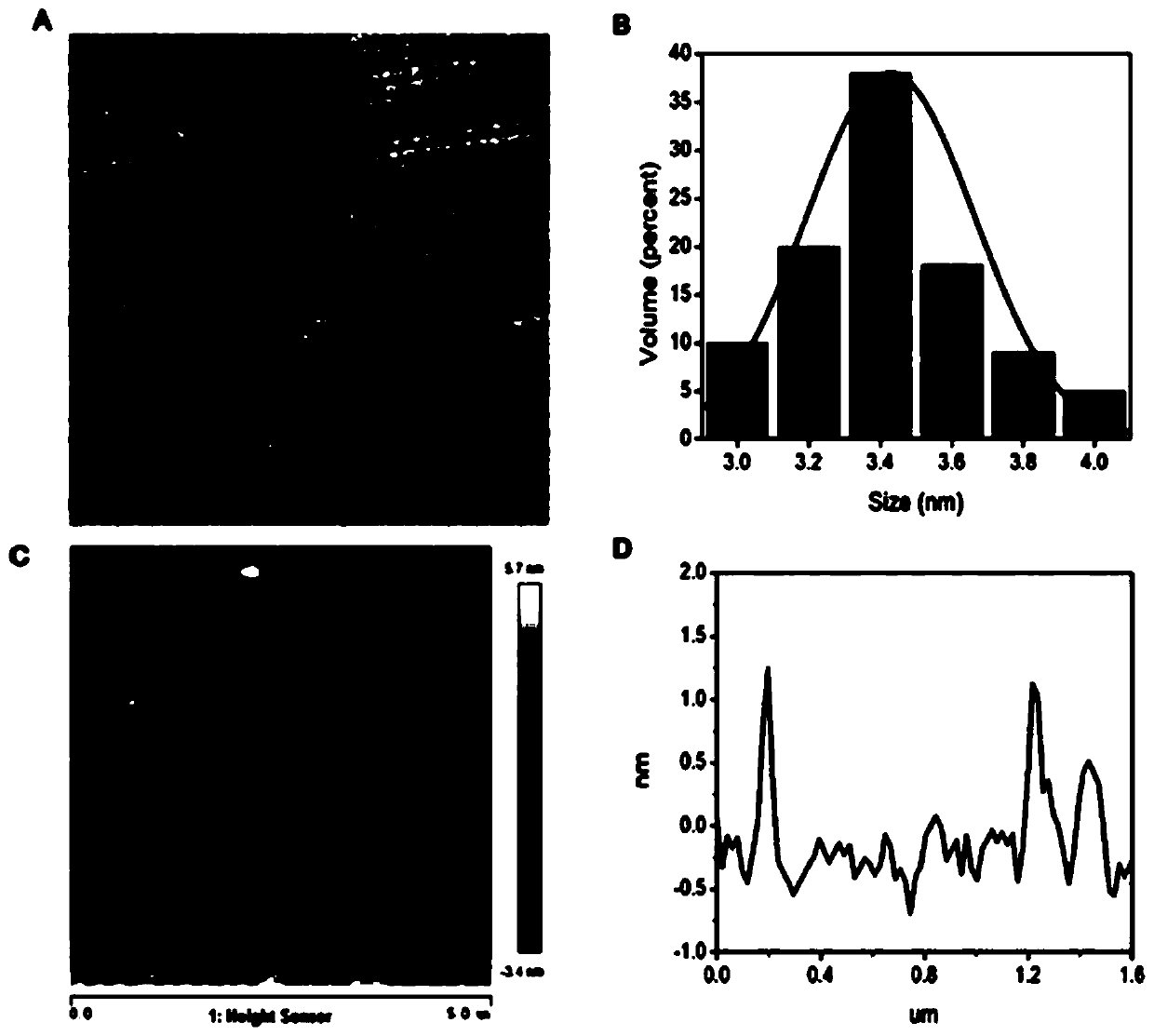Composite nano-probe based on N-Ti<3>C<2>QDs and o-phenylenediamine oxide, and ratio fluorescence detection method thereof
An o-phenylenediamine and nano-probe technology is applied in the field of analysis and detection, which can solve the problems of inaccurate number of detection probes, micro-environmental interference, high system error, etc., and achieve the effect of improving the fluorescence quantum yield.
- Summary
- Abstract
- Description
- Claims
- Application Information
AI Technical Summary
Problems solved by technology
Method used
Image
Examples
Embodiment 1
[0047] A N-Ti based 3 C 2 Composite nanoprobes of QDs and o-phenylenediamine oxide for H 2 o 2 A ratiometric fluorescence detection method comprising the steps of:
[0048] (1)N-Ti 3 C 2 Synthesis of QDs: 15mg Ti 3 C 2 MXene was dissolved in 15mL DMF, N 2 Ultrasonic deoxygenation under protection for 30min, NH 3 ·H 2 O to adjust the pH to 9.0, followed by N 2 Under protection, it was quickly transferred to a reaction kettle for reaction at 120°C for 6 hours, cooled to room temperature and filtered through a 0.22 μm microporous membrane.
[0049] N-Ti 3 C 2 For the characterization of QDs see figure 1 and figure 2 .
[0050] figure 1 A and B are respectively N-Ti 3 C 2 TEM and size distribution of QDs, calculated and analyzed by ImageJ, N-Ti 3 C 2 QDs are evenly distributed, with an average particle size of 3.4±0.5nm; figure 1 The inset in A is the HRTEM image, which further reveals the N-Ti 3 C 2 Crystal characteristics of QDs. figure 1 C, D are the fu...
Embodiment 2
[0056] A N-Ti based 3 C 2 The compound nanoprobe of QDs and o-phenylenediamine oxide is used for the ratio fluorescence detection method of xanthine, comprises the following steps:
[0057] (1)N-Ti 3 C 2 Synthesis of QDs: 15mg Ti 3 C 2 MXene was dissolved in 15mL DMF, N 2 Ultrasonic deoxygenation under protection for 30min, NH 3 ·H 2 O to adjust the pH to 9.0, followed by N 2 Under protection, it was quickly transferred to a reaction kettle for reaction at 120°C for 6 hours, cooled to room temperature and filtered through a 0.22 μm microporous membrane.
[0058] (2)N-Ti 3 C 2 Preparation of QDs@DAP probe: Mix 150 μL of xanthine solutions with concentrations of 1 μM, 10 μM, 25 μM, 40 μM, and 50 μM with 190 μL of o-phenylenediamine at a concentration of 40 mM and 10 μL of xanthine oxidase at a concentration of 100 μg / mL , 10 μL of horseradish peroxidase with a concentration of 8 U / mL and 200 μL of PB buffer solution were mixed and incubated at 37° C. in the dark for 5...
Embodiment 3
[0062] Selective experiment of detection method of the present invention
[0063] 1) Detection of H 2 o 2 The selectivity: repeat step 2) and step 3) among the embodiment 1), the H wherein 2 o 2 Replaced with dopamine, ascorbic acid, phenylalanine, glucose, lysine, L-cysteine, tyrosine, glutathione, oxidized glutathione, K + ,Mg 2+ , Ca 2+ , Na + ,Zn 2+ ,Cd 2+ , Fe 2+ , Ag + ,I - and Br - Interfering substances, other conditions remain unchanged, detection of fluorescence, get this method to detect H 2 o 2 The selectivity result graph (see Figure 5 ).
[0064] Figure 5 Among them, DA, AA, Phe, Glu, Lys, L-Cys, Tyr, GSH, GSSG are respectively dopamine, ascorbic acid, phenylalanine, glucose, lysine, L-cysteine, tyrosine, gluten Glutathione, oxidized glutathione, it can be seen from the figure that this method has good selectivity to the target H2O2.
[0065] 2) Selectivity of xanthine detection: repeat step 2) and step 3) in Example 2, replace xanthine therei...
PUM
| Property | Measurement | Unit |
|---|---|---|
| pore size | aaaaa | aaaaa |
Abstract
Description
Claims
Application Information
 Login to View More
Login to View More - R&D
- Intellectual Property
- Life Sciences
- Materials
- Tech Scout
- Unparalleled Data Quality
- Higher Quality Content
- 60% Fewer Hallucinations
Browse by: Latest US Patents, China's latest patents, Technical Efficacy Thesaurus, Application Domain, Technology Topic, Popular Technical Reports.
© 2025 PatSnap. All rights reserved.Legal|Privacy policy|Modern Slavery Act Transparency Statement|Sitemap|About US| Contact US: help@patsnap.com



